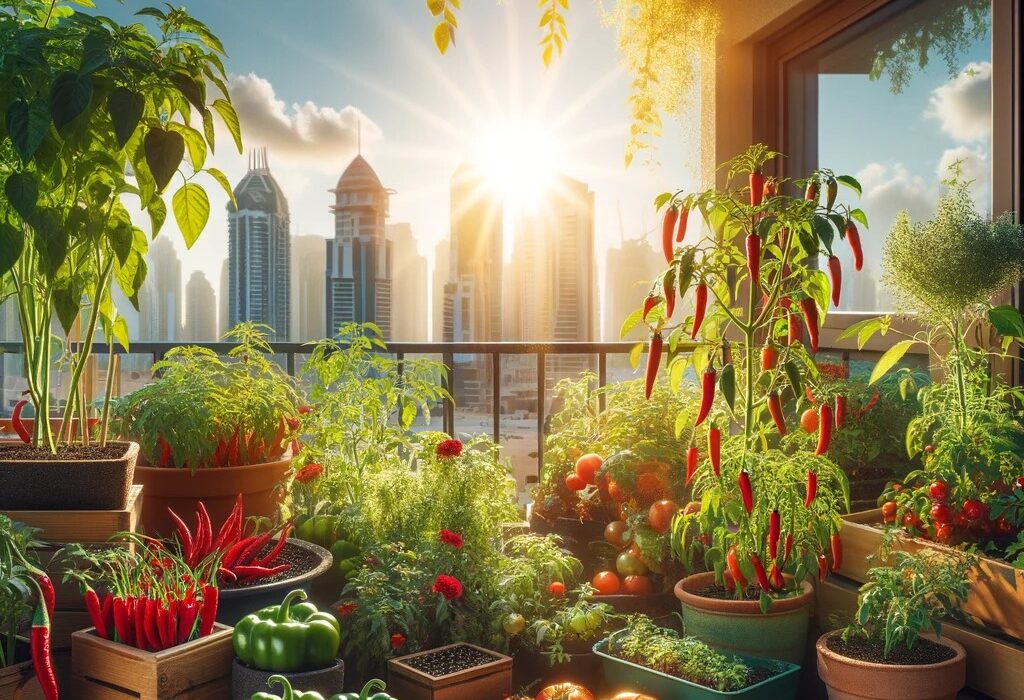Do you want to turn your small space into a flavorful and fresh haven of greenery?
Living in the UAE, kitchen gardens are very precious. To maximize your harvest and create an ecosystem, companion planting comes in handy.
You can make the most of your kitchen garden and turn it into a beautiful home where plenty of natural elements exist peacefully.
What is companion planting?
Companion planting is the planting of two or more plants together for the benefit of one or both plants.
It is a sustainable and natural way to manage pests and improve overall garden health, often reducing the need for chemical pesticides and fertilizers.
It promotes whole-plant gardening that focuses on plant species and collaboration, which eventually results in more flourishing and productive garden settings.
Here we have taken tomatoes and chilies, a dynamic duo that shines in the garden.
Why Pair Chillies with Tomatoes?
Tomatoes, juicy fruits, are grown in warm, sunny environments with well-drained soil.
The colorful and spicy flavors of chilies add a spicy zest to the garden. These heat-loving plants grow similarly to tomatoes, which makes them perfect garden companions. They are rich in vitamins and antioxidants.
Pest Patrol: Chillies strong aroma repels common tomato pests like whiteflies and tomato hornworms. This natural defense can save you from using harsh chemicals.
Shared Benefits: Both chilies and tomatoes love well-drained, sunny spots with slightly acidic soil. By sharing space, you optimize your balcony or your garden
Pollinator Party: The fragrant blooms of both plants attract helpful pollinators like bees and butterflies, boosting fruit production.
Benefits of Companion Planting
Welcome to the amazing world of companion planting, where cooperation and teamwork bring gardens to life! Plants in a companion garden collaborate to grow as much as in a close-knit community.
It’s not just about arranging plants; it’s an approach that utilizes the natural relationships between various species to build healthy ecosystems.
Nutrient Uptake
Companion planting optimizes soil nutrients by pairing plants with different nutrient needs, minimizing competition, and maximizing nutrient uptake.
Plants that require different nutrients from one another combine to form an ecosystem that reduces resource conflict.
Plants work best when paired together since their nutritional needs complement one another’s, avoiding the soil’s ability to lose certain nutrients.
Space Optimization:
Companion planting increases available space by combining plants with changing heights and growth patterns, resulting in more gardens. It’s also a resourceful method of maximizing a small garden area. Companion planting maximizes the potential of your garden by carefully matching plants with varying development requirements and spatial tastes.
Weed suppression:
Companion plants shade the soil or release chemicals that prevent weed growth, minimizing the need for manual weeding.
By selecting plant combinations that shade the soil, release allelopathic compounds, and promote soil health, you can create a weed-resistant landscape that requires little maintenance.
So, say goodbye to back-breaking weeding and embrace the beauty and usefulness of companion planting.
Improved Pollination:
By attracting beneficial insects like bees and butterflies, companion plants boost pollination rates, leading to better fruit and vegetable yields.
So, as you design your garden, keep in mind the crucial role companion plants play in arranging this pollination symphony and invite nature performers to increase the life of your green haven.
In the art of gardening, companion planting with chilies and tomatoes emerges as a harmonious partnership that benefits both plants and gardeners alike.
For a genuinely rewarding and fruitful growing experience, whether you’re an experienced gardener or a beginner, think about utilizing the potential of companion planting with tomatoes and chilies in your garden.



